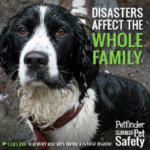Disaster Preparedness
Dogs: Disaster Preparedness Shopping List
Petfinder
EMERGENCY ANIMAL RESCUE SERVICE (EARS)
Are you prepared to take care of your dog when a disaster strikes? If not, NOW is the time to stock up on the items that you will need so you will not get caught unprepared.
Listed below is a handy shopping list for you to use. The next time you buy food or supplies for your dog, take this list with you. Don’t put off doing what you should do now – it may just make the difference between being able to keep your dog alive when a disaster strikes.
Here are the supplies that you should have in a disaster kit for dogs. Adjust the amounts, depending on the number of dogs that you have.
1. FOOD
Always have a reserve supply of the type of food your dog is used to eating that would last at least a week. If your dog eats canned food, buy cans small enough to be used at one feeding since you may not have a way to properly refrigerate any left over food, and buy pop top cans if you can since you may not have access to a can opener (you should include a can opener with your disaster supplies just in case though). Store food in an airtight, water proof container and rotate food at least once every (3) months. Include with your disaster supplies an extra feeding dish, just in case the one normally used is lost. Include with your disaster supplies a spoon to scoop and/or mix food.
2. WATER
Have enough drinking water to last at least one week for each dog in your household. Store water in a cool, dark location, and be sure to rotate it so it remains fresh, remember that if the tap water is not suitable for humans to drink, it is also not suitable for animals to drink. Include with your disaster supplies an extra water dish, just in case the one normally used is lost.
3. SANITATION
Have a pooper scooper in your disaster supplies for picking up after your dog. Have some plastic bags in your supplies for disposing of your dog’s waste, you may want to purchase some disposable pooper scooper bags at a pet supply store.
4. CLEANING SUPPLIES
Include with your disaster supplies a small container of soap for washing out your dog’s food dish. Include with your disaster supplies some paper towels for drying dishes and other cleanup if you will be housing your dog in a crate, include with your disaster supplies a disinfectant that can be used to clean the crate.
5. COLLAR AND TAG
A proper fitting collar and an identification tag should be kept on your dog at all times, and an extra collar and identification tag should be kept with your disaster supplies should the permanent ones get lost during a disaster (do not keep a choke collar on a dog all the time, as your dog may accidentally get it caught on something and choke itself. Have a spare identification tag with your disaster supplies that you can write on, so that if you are going to be living somewhere temporarily you can put the phone number and address of that location on the tag. Keep a proper fitting dog harness and at least a 6 foot long leash with your disaster supplies to be used when you walk your dog – this is a stressful time for dogs too, and a frightened dog can slip out of a collar, but not a harness.
6. TEMPORARILY CONFINING YOUR DOG
You may wish to purchase a plastic airline crate or a wire collapsible crate to transport your dog should you have to evacuate and/or to keep the dog in following a disaster – be sure the crate is large enough for your dog to lie down comfortably and allow room for a food and water dish (remember that fences and walls can come down during a disaster, making it easier for a dog to escape and get lost). You may wish to purchase a metal stake that screws into the ground, with a place to fasten a dog chain – be sure if you stake your dog out to provide protection from the hot sun, extreme cold, snow, or rain – a dog house should be placed within reach to protect the dog – it is also important when staking out a dog that you do not leave it somewhere that other aggressive animals might be able to get to it. When staking a dog, be sure to use a chain and not a leash that the dog can chew through – also be sure that the dog is not chained in a place where it could fall off of something and hang itself (for example, an elevated porch).
7. FIRST AID KIT
Check with your veterinarian to find out what he/she recommends you include in your first aid kit.
Some suggested items include:
- first aid book for dogs
- conforming bandage (3? x 5?)
- absorbent gauze pads (4? x 4?)
- absorbent gauze roll (3? x 1 yard)
- cotton tipped applicators (1 small box)
- antiseptic wipes (1 package)
- emollient cream (1 container)
- tweezers and scissors
- instant cold pack
- latex disposable gloves (several pairs)
- proper fitting muzzle
Courtesy of United Animal Nation’s Emergency Animal Rescue Service
For more information please call (800) 440-EARS or visit http://www.uan.org/